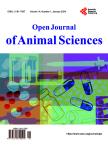Productive Response and Reproductive Performance of Dairy Cows Subjected to Different Feeding Systems
Productive Response and Reproductive Performance of Dairy Cows Subjected to Different Feeding Systems作者机构:Area de Investigación en Producción Animal Instituto Nacional de Tecnología Agropecuaria (INTA) Rafaela Argentina Agencia de Extensión Rural Necochea Instituto Nacional de Tecnología Agropecuaria (INTA) Necochea Argentina Area de Investigación en Producción Animal Instituto Nacional de Tecnología Agropecuaria (INTA) Balcarce Argentina
出 版 物:《Open Journal of Animal Sciences》 (动物科学期刊(英文))
年 卷 期:2020年第10卷第1期
页 面:10-32页
主 题:Milk Yield Reproduction Dairy Cow Feeding Systems
摘 要:Fifty Holstein cows (2.6 ± 1.0 lactations) in early lactation (52.6 ± 16.4 days in milk) calved in autumn and producing 34.3 (±4.4) kg milk per cow·day-1 were randomly assigned for 27 weeks to one of two treatments (feeding systems) in 10 groups (pens) of 5 animals each (5 groups/treatment). The confined treatment was a total mixed ration (TMR_100) whereas the supplemented grazing system was defined by a partially mixed ration (PMR_75) with 75% TMR and 25% oat pasture (Avena sativa L.) during the autum-winter (Period I) and alfalfa pasture (Medicago sativa L.) plus concentrate (7.0 kg per cow·day-1) (P + C) during the next spring (Period II). Milk production was daily and individually recorded throughout the trial while the chemical composition of milk was measured on individual samples every 2 weeks. Live weight (LW) and body condition score (BCS) using a scale of 1 to 5 were recorded every 3 weeks after the morning milking. Simultaneously, blood samples were taken for determinations of glucose, urea, non-esterified fatty acids (NEFA), insulin, somatotrophin (GH) and somatomedin C (IGF-I). Total DM intake was measured using the difference method four times per repetition in the months of July, August, September and October. The experimental herd was inseminated at fixed time at the start of the service (May-July) and on the return with estrus detection. The diagnosis of pregnancy was made by transrectal ultrasonography at 30 and 60 days after the start of the service. The productive data were analyzed according to a model with repeated observations in time adjusted by covariate with 2 periods and using the animal as the experimental unit. Data of DM intake were analyzed using ANOVA for 2 treatments with 5 repetitions. Cows from the TMR_100 group produced more milk (kg·cow-1·day-1) during Period I (33.7 vs. 32.3) and Period II (28.8 vs. 27.8) (P ·cow-1·day-1) in Periods I (1.33 vs. 1.24) and II (1.10 vs. 0.92) and for milk protein (1.19 vs. 1.13



